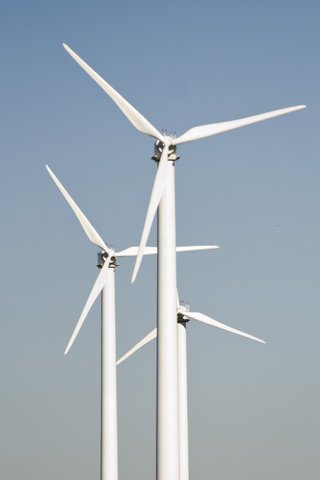Texas has been drawing in an accelerating wave of investment in wind power, producing far and away more wind power than any other state since 2006, when it first passed California.
Companies have brought more than 13,000 wind turbines to Texas, according to data from The United States Wind Turbine Database, chasing some combination of reliable regulatory environment, state-financed transmission lines and, of course, windy plains. In exchange for investments in wind power often worth hundreds of millions of dollars each, Texas school districts opted out of taxes on wind farm property valued at $6.84 billion as of 2015, according to a 2017 Texas comptroller review of the Chapter 313 incentive program, which governs the deals.
Massive companies like Dallas-based AT&T Inc. (NYSE: T), Amazon (Nasdaq: AMZN) and Nike (NYSE: NKE) have been supporting newly built wind farms in the Lone Star state via source-specific power supply agreements with the companies building them. Others, like Ikea, have purchased wind farms outright.
One of the NextEra Energy Inc. (NYSE: NEE) wind farms supported by an AT&T agreement will cost about $277.75 million to build, according to an application for Chapter 313 incentives published by the comptroller. Amazon Wind Farm Texas — built, owned and operated by Lincoln Clean Energy in Snyder County, but supported by an agreement with Amazon — cost $292 million to build, according to its own comptroller application.
The AT&T farm draws tax incentives to the tune of $33.66 million over the course of the 10-year agreements, of which $22.17 million comes from a Chapter 313 agreement, according to comptroller documents. The Amazon farm will save about $17.02 million in 10 years because of its 313 agreement and another $11.12 million over the same period for county-level tax incentives, according to comptroller documents.
Ikea’s Cameron I wind farm cost about $267.33 million to build, and it’s Chapter 313 agreement is expected to save the company $16.22 million over 10 years.
The whole 313 program, which primarily covers renewable power and manufacturing projects, cost Texas school districts $513.2 million in annual taxes last year, according to another 2017 comptroller report. That number was projected to rise to $1.09 billion in 2022, according to that report. School districts, however, rarely feel the economic downside to those deals individually. In fact, any given school district can come out with a net increase to its revenue, even though it’s giving up taxable value to the corporations behind the large infrastructure projects on the other side of the negotiating table, depending on the terms of the deal, according to a spokesperson for the Texas comptroller.
Corporations can make supplemental payments returning a portion of their tax break to the school district, but such payments happen outside of the school funding formula. At the same time, the revenue forgone by the school district is already “substantially replaced” by that same funding formula, the comptroller spokesperson said.
That means school districts are sometimes incentivized to make Chapter 313 agreements that aren’t in the best interest of the state of Texas as a whole, according to a 2010 report by Susan Combs, who was comptroller at the time.
The comptroller spokesperson noted that the current comptroller has not expressed the same misgivings about supplemental payments Combs did in her 2010 report, which recommended eliminating the payments entirely.
The law behind 313 incentives underwent some changes in 2013, but revenue protection for schools remained the same, and supplemental payments were “only very slightly modified,” according to the spokesperson.
Of the 402 active Chapter 313 agreements, 193 went to wind power projects, 170 to manufacturing projects and 33 to other renewable power projects, according to data released by the Texas comptroller in October. There were also four research and development and two nuclear power projects, according to the October data. That’s up from 311 total projects as of 2015, according to the 2015 data.
School districts gave up taxes on $12.03 billion in manufacturing property value through the program in 2015, while wind power facilities had $6.84 billion in untaxed value, according to the 2015 data, which is the most recent data around the total dollar figures published by the comptroller. Non-wind renewable power facilities saw $346.56 million of their value go untaxed under 313 agreements, according to the data.
The 2017 report said that renewable energy projects were returning 20 percent of their tax benefit in supplemental payments to the school districts, while manufacturing projects gave back 11 percent in the same way.
But do they work?
There’s generally not a financial risk to school districts awarding these incentives, said Daniel Casey, a partner at Moak, Casey and Associates. Casey negotiates on behalf of many of the school districts that take part in these incentives.
At the same time, Casey said he still thinks the incentives have some effect toward their stated goal — increasing investment in Texas.
“I don’t think it’s all window dressing,” Casey said. “That’s never been my sense of it.”
Many neighboring states, like Louisiana, give out similar or more extreme tax abatements to incoming industrial projects, Casey said. If Texas wants to compete for that investment, anything it can do to give better returns to the companies matters, he added.
“The purpose is to attract capital investment, which it does,” Casey said.
That question — whether the incentives actually attract investment that wouldn’t be coming to Texas anyway — is a tough one to answer definitively, said George Francis, a Deloitte managing director who assists the corporations seeking the incentives.
“It is the question that has bedeviled economic development people forever,” Francis said.
School districts and companies can negotiate around the details of the deals — things like employment requirements and the size of supplemental payments — but whether a potential deal closes and whether a company invests in the district at all usually rests on the economics of a project, Francis said. Economic incentives help push that needle in Texas’ favor.
Francis said that, anecdotally, he’s had clients who couldn’t make an investment decision without knowing whether they would get the incentives.

Nate Jensen, a professor with the University of Texas’s Department of Government, said most projects covered by 313 agreements would locate in Texas even without the incentives. His research uses the size of supplemental payments as a proxy for a project’s ability to locate elsewhere — the research contends that if a project can’t find competitive sites in other states, it’s more likely to offer large supplemental payments to make up for its weaker bargaining position. Less than 15 percent of projects participating in the 313 program would have located outside of Texas without the incentive, Jensen said in his research paper, which was peer reviewed and published in the academic journal Public Choice.


